canonization
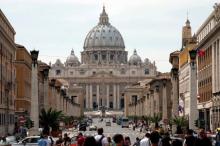
Hundreds of pilgrims wind their way around St. Peter’s Square as tour guides shout in multiple languages. Beggars have their hands outstretched amid warnings of an invasion of pickpockets from abroad.
Italian authorities are expecting at least a million pilgrims, including heads of state, prime ministers, and diplomats from 54 countries. One group of Polish pilgrims is making the 2,000-mile trek on horseback, dressed in medieval costumes, to celebrate Poland’s most famous native son.
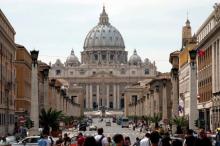
VATICAN CITY — While millions of pilgrims are expected to attend the Catholic Church’s first-ever double canonization at the end of April, the Vatican is preparing its most ambitious TV and social media campaign for the millions who don’t make it to Rome.
For the first time viewers will be able to watch the historic event live in 3-D movie theaters in 20 countries across North and South America and Europe through a deal between Vatican TV and Rupert Murdoch’s Sky TV network, Sony, and other partners. City officials are expecting more than 5 million people to attend the ceremony when Pope Francis declares his predecessors Pope John Paul II and Pope John XXIII saints in St Peter’s Square on April 27.

Pope John Paul II won’t officially become a saint until a special high-profile ceremony next month at the Vatican. But the man who succeeded him says he has seen him in that light for years.
The Polish pontiff “did not ask for applause and never looked troubled when he was making difficult decisions,” Benedict said. “He acted in accord with his faith and beliefs, and he was willing to endure blows against him. I could and should not imitate him, but I did try to continue his legacy and his mission the best way I could.”
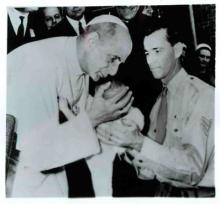
Vatican theologians have given their approval to a miracle attributed to the intercession of Pope Paul VI, moving him a step closer to sainthood.
The team of medical professionals and doctors that advise the Vatican’s Congregation for the Causes of Saints already had approved the same miracle in December. Now that a panel of theologians has signed off, the miracle only requires a review by Pope Francis to be considered official.
When that happens, Paul will be beatified — the final step before sainthood. A second miracle is typically required for canonization.
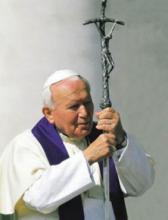
A vial containing the blood of the late Pope John Paul II was stolen from a village church in a mountainous area east of Rome, sparking a regionwide manhunt that includes more than 50 police and a team of dogs specialized in tracking.
It is not clear when the break-in at the small Church of San Pietro della Lenca in the region of Abruzzo took place, but it was discovered by a church custodian on Sunday. The thief or thieves made off with a large crucifix and a gold reliquary containing the vial of the blood of John Paul, who will be proclaimed a saint in April.
Once John Paul is elevated to sainthood, artifacts from his life will increase in value.
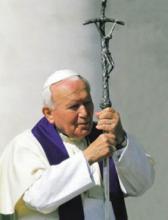
Vatican officials say they expect next year’s celebration for the canonizations of former popes John Paul II and John XXIII to be attended by as many as 100 heads of state in what is likely to be the biggest draw to the city since John Paul’s funeral in 2005.
The crowd estimates were made Tuesday, the feast day for John Paul. This will be the last time he will be venerated as Blessed Pope John Paul II; after the canonization ceremony on April 27, 2014, he will be known as St. Pope John Paul II.
John Paul’s 2005 funeral may have been the single largest gathering in Christian history, with estimates as high as 4 million mourners gathered in the Italian capital, along with at least 80 presidents, prime ministers, and monarchs.
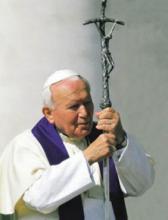
Popes John Paul II and John XXIII will be formally declared saints on April 27, 2014, the Vatican said Monday. Pope Francis made the announcement during a meeting with cardinals gathered in Rome.
John Paul, who was pope from 1978 to 2005, and John, who reigned from 1958 to 1963, are considered two of the most influential religious leaders in the world in the last century, and they represent two poles in Roman Catholicism — John XXIII is a hero to liberals, while John Paul II is widely hailed by conservatives.

Pope Francis declared on Friday that Popes John Paul II and John XXIII will be made saints, elevating the two most decisive popes of the 20th century to the pantheon of Catholic life and worship.
In a sign of the worldwide devotion for John XXIII, known as “Good Pope John,” Francis waived the requirement for a second miracle credited to John XXIII’s intercession, with the Vatican’s spokesman saying, “no one doubts his virtues.”
Francis signed off on a decree recognizing the second miracle attributed to the Polish-born John Paul II, who reigned from 1978 to 2005 , and is credited with globalizing the papacy and playing a key role in the downfall of the communist regimes of Eastern Europe.
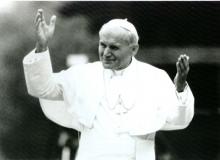
Reports this week that the late Pope John Paul II may be on the verge of sainthood after a second miracle was credited to his intercession aren’t a huge surprise: When he died eight years ago, crowds were already clamoring for his canonization, and Pope Benedict XVI quickly waived the usual five-year waiting period to get the process rolling.
But the news that Pope Francis, just six weeks on the job, has cleared the way for the long-stalled canonization of martyred Salvadoran Archbishop Oscar Romero is a stunner that sends another important signal about the new pope’s priorities.
“Sainthood is often as much about politics and image as anything else,” said the Rev. Harvey Egan, a Jesuit priest and professor emeritus of theology at Boston College.
“It’s not surprising to me that this present pope being from South America, having the same inclinations as Romero, would unblock the process and say ‘Push his cause through,’ and I think rightly so.”

BALTIMORE — The Catholic bishops gathered here for their annual meeting couldn’t agree on a statement on the economy on Tuesday morning, but with a unanimous voice vote that afternoon they easily backed a measure to push sainthood for Dorothy Day, whose life and work were dedicated to championing the poor.
Indeed, it was a remarkable moment for the reputation of Day, one of the most famous figures in 20th-century Catholicism.
Born in Brooklyn in 1897, Day lived a bohemian life in New York City in the 1920s while working as a leftwing journalist. She endured a failed marriage, a suicide attempt, and had an abortion when suddenly, after the birth of her daughter, she converted to Catholicism.
That decision confounded her literary friends but launched her on a new path of activism and piety.
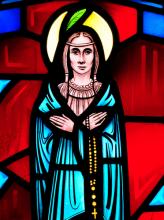
MOHAWK VALLEY, New York — Twelve-year-old Jake Finkbonner leaned over and ran his hand through a pool of water from a natural spring at the National Shrine of Blessed Kateri Tekakwitha, in Fonda, N.Y.. With that simple gesture, on a recent July weekend, the boy connected literally to the story of the 17th-century Native American woman who the Roman Catholic Church will elevate to sainthood on Oct. 21.
Jake had already connected to her story in what he believes is a miraculous way. The boy's inexplicable recovery from a flesh-eating illness in 2006 is attributed to prayers to Kateri (pronounced Gad-a-lee in Mohawk) on his behalf.
Jake, who is of Lummi descent, said he's gotten used to the attention he draws when people learn he's at the center of the miracle that led the Vatican to decide to proclaim Kateri a saint — a step that will make her one of the church's holy role models, and the first Native American to be canonized.
He likes to read and play basketball, and he loves video games. He and his 10-year-old sister, Miranda, are also training to become altar servers.
"I feel a great amount of gratitude and thanks to her," Jake said of Kateri.